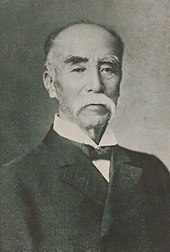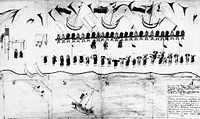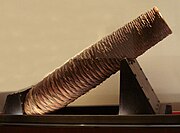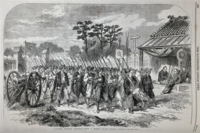Bakumatsu
| Part of a series on the |
| History of Japan |
|---|
 |
Bakumatsu (幕末, "End of the
Although these two groups were the most visible powers, many other factions attempted to use the chaos of bakumatsu to seize personal power.[1][page needed] Furthermore, there were two other main driving forces for dissent: first, growing resentment on the part of the tozama daimyō (or outside lords), and second, growing anti-Western sentiment following the arrival of Matthew C. Perry. The first related to those lords whose predecessors had fought against Tokugawa forces at the Battle of Sekigahara in 1600, after which they had been permanently excluded from all powerful positions within the shogunate. The second was to be expressed in the phrase sonnō jōi, or "revere the Emperor, expel the barbarians". The turning point of the Bakumatsu was during the Boshin War and the Battle of Toba–Fushimi when pro-shogunate forces were defeated.[2][page needed]
Background
Frictions with foreign powers
Frictions with foreign shipping led Japan to take defensive actions from the beginning of the 19th century. Western ships were increasing their presence around Japan due to

Meanwhile, Japan endeavoured to learn about foreign sciences through
Following the
A national debate was already taking place about how to better avoid foreign incursions. Some such as Egawa claimed that it was necessary to use the foreigners' techniques to repel them. Others, such as
After 1839, however, traditionalists tended to prevail. Students of Western sciences were accused of treason (Bansha no goku), put under house arrest (Takashima Shūhan), forced to commit ritual suicide (Watanabe Kazan, Takano Chōei), or even assassinated as in the case of Sakuma Shōzan.
-
Thedemanded supplies while in Nagasaki harbourin 1808.
-
The AmericanEdo Bayin 1837.
-
Russians meeting Japanese in 1779
Perry Expedition (1853–54)
When
Japan's response
In response to the Perry Expedition and increasing incursions of foreign warships into Japanese territorial waters, several modern sailing frigates, including
-
Shōhei Maru
-
Odaiba battery at the entrance of Tokyo, built in 1853–54 to prevent an American intrusion
-
Coastalbakufu for Commodore Perry's arrival
-
Izunokuni, Shizuoka built by Egawa Hidetatsu. Construction began in November 1853 and was completed in 1857; it operated until 1864.[a]
-
One of the cannons of Odaiba, now at the Yasukuni Shrine. 80-pound bronze; Bore: 250mm, length: 3830mm.
-
Marquess Kuroda Nagahiro of Fukuoka. Nagahiro (like his close relative, Shimazu Nariakira) was a serious proponent of technological modernization after Commodore Perry's arrival. He greatly encouraged learning amongst his retainers, and sent them to the best schools of Edo, Osaka, and Nagasaki to absorb the Western knowledge and technical expertise which was entering the country at the time.
The American fleet returned in 1854. The chairman of the senior councillors,

The resulting damage to the shogunate was significant. Debate over government policy was unusual and had engendered public criticism of the shogunate. In the hope of enlisting the support of new allies, Abe, to the consternation of the
In the
Opposition to Abe increased within fudai circles, which opposed opening shogunate councils to the tozama daimyō, and he was replaced in 1855 as chairman of the senior councilors by
Japanese historian
-
The Kanrin Maru, Japan's first screw-driven steam warship, 1855
-
TheNagasaki, near Dejima
Earthquakes
The years 1854–1855 saw a dramatic series of earthquakes, known as the
-
The wreckage ofIllustrated London News, 1856
Treaties imposed upon Japan

Following the nomination of Townsend Harris as the U.S. Consul in 1856 and two years of negotiation, the Treaty of Amity and Commerce was signed in 1858 and put into application from mid-1859. During the negotiations, Harris had convinced the Japanese negotiators to sign the treaty on the basis it was the best possible terms a Western power would offer.[14][15]
The most important points of the Treaty were:
- exchange of diplomatic agents.
- Niigata, and Yokohama's opening to foreign trade as ports.
- ability of United States citizens to live and trade at will in those ports (only opium trade was prohibited).
- a system of extraterritoriality that provided for the subjugation of foreign residents to the laws of their own consular courts instead of the Japanese law system.
- fixed low import-export duties, subject to international control
- ability for Japan to purchase American shipping and weapons (three American steamships were delivered to Japan in 1862).
Japan was also forced to apply any further conditions granted to other foreign nations in the future to the United States, under the "most favoured nation" provision. Several foreign nations soon followed suit and obtained treaties with Japan (the
Trading houses were quickly set up in the open ports.
-
Map of newly opened Yokohama Port 1859-1860
-
View of Yokohama in 1859
Crisis
Collapse of the Japanese economy
| Japanese foreign trade (1860–1865, in Mexican dollars)[16]
| ||
| 1860 | 1865 | |
Exports
|
4.7 million | 17 million |
Imports
|
1.66 million | 15 million |
The opening of Japan to uncontrolled foreign trade brought massive economic instability. While some prospered, many others went bankrupt. Unemployment rose, as well as inflation. Coincidentally, major famines also increased the price of food drastically. Incidents occurred between brash foreigners and the Japanese.
Japan's monetary system, based on Tokugawa coinage, also broke down. Traditionally, Japan's exchange rate between gold and silver was 1:5, whereas international rates were of the order of 1:15. This led to massive purchases of gold by foreigners, and ultimately forced the Japanese authorities to devalue their currency.[17] There was a massive outflow of gold from Japan, as foreigners rushed to exchange their silver for "token" silver Japanese coinage and again exchange these against gold, giving a 200% profit to the transaction. In 1860, about 4 million ryōs thus left Japan,[18] that is about 70 tons of gold. This effectively destroyed Japan's gold standard system, and forced it to return to weight-based system with International rates. The Bakufu instead responded to the crises by debasing the gold content of its coins by two thirds, so as to match foreign gold-silver exchange ratios.[18]
Foreigners also brought cholera to Japan, leading to hundreds of thousands of deaths.[17]
-
Foreign ships in Yokohama harbor
-
A foreign trading house in Yokohama in 1861
-
Allegory of inflation and soaring prices during the Bakumatsu era
Political and social crisis

Tairō Ii Naosuke, who had signed the Harris Treaty and tried to eliminate opposition to Westernization with the Ansei Purge, was himself murdered in March 1860 in the Sakuradamon incident. A servant of the French Minister was attacked at the end of 1860.[19] On 14 January 1861, Henry Heusken, Secretary to the American mission, was attacked and murdered.[19] On 5 July 1861, a group of samurai attacked the British Legation, resulting in two deaths.[19] During this period, about one foreigner was killed every month. The Richardson Affair occurred in September 1862, forcing foreign nations to take decisive action in order to protect foreigners and guarantee the implementation of Treaty provisions. In May 1863, the US legation in Edo was torched.
During the 1860s, peasant uprisings and urban disturbances multiplied. A "World renewal" movement appeared, as well as religious festivals and protests such as the Eejanaika.[citation needed]
From 1859, the ports of
-
Attack on the British legation in Edo, July 1861
-
Assassination of Tairō Ii Naosuke in the Sakuradamon incident (1860)
Initial efforts to revise the imposed treaties
Several missions were sent abroad by the Bakufu, in order to revise the commercial treaties. However, these efforts remained largely unsuccessful. A
-
The members of the First Japanese Embassy to Europe (1862) visiting the 1862 International Exhibition in London, from the Illustrated London News
Sonnō Jōi (1863–66)

Belligerent opposition to Western influence further erupted into open conflict when the Emperor Kōmei, breaking with centuries of imperial tradition, began to take an active role in matters of state and issued, on March 11 and April 11, 1863, his "Order to expel barbarians" (攘夷実行の勅命, jōi jikkō no chokumei).
The Mōri clan of
Under pressure from the Emperor, the Shogun was also forced to issue a declaration promulgating the end of relations with foreigners. The order was forwarded to foreign legations by Ogasawara Zusho no Kami on June 24, 1863:
"The orders of the Tycoon, received from Kyoto, are to the effect that the ports are to be closed and the foreigners driven out, because the people of the country do not desire intercourse with foreign countries."
— Missive of Ogasawara Dzusho no Kami, June 24, 1863, quoted in A Diplomat in Japan, Ernest Satow, p75
Edward Neale, the head of the British Legation, responded on very strong terms, equating the move with a declaration of war:
"It is, in fact, a declaration of war by Japan itself against the whole of the Treaty Powers, and the consequences of which, if not at once arrested, it will have to expiate by the severest and most merited chastisement"
— Edward Neale, June 24, 1863. Quoted in A Diplomat in Japan, Ernest Satow, p77
-
An 1861 image expressing theJōi(攘夷, "Expel the Barbarians") sentiment
-
Japanese cannons shooting on Foreign shipping at Shimonoseki in 1863
Foreign military interventions against sonnō jōi
American influence, which had been of high importance in the beginning, waned after 1861 due to the advent of the American Civil War (1861–1865) that monopolized all available U.S. resources. This influence would be replaced by that of the British, the Dutch and the French.
The two ringleaders of the opposition to the bakufu were from the Satsuma (present day Kagoshima prefecture) and Chōshū (present-day Yamaguchi prefecture) provinces, two of the strongest tozama anti-shogunate domains in Edo-period Japan. Satsuma military leaders
In the morning of July 16, 1863, under sanction by Minister Pruyn, in an apparent swift response to the attack on the Pembroke, the U.S. frigate USS Wyoming under Captain McDougal sailed into the strait and single-handedly engaged the U.S.-built but poorly manned fleet. For almost two hours before withdrawing, McDougal sank one Japanese vessel and severely damaged the other two, along with some forty Japanese casualties, while the Wyoming suffered extensive damage with fourteen crew dead or wounded.
-
The USS Wyoming battling in the Shimonoseki Straits against the Choshu steam warships Daniel Webster (six guns), the brig Lanrick (Kosei, with ten guns), and the steamer Lancefield (Koshin, of four guns)
-
USS Wyoming sinking the Choshu steamer Lancefield
On the heels of McDougal's engagement, two weeks later a French landing force of two warships, the Tancrède and the
In August 1863, the Bombardment of Kagoshima took place, in retaliation for the Namamugi incident and the murder of the English trader Richardson. The Royal Navy bombarded Kagoshima and sunk several ships. Satsuma however later negotiated and paid 25,000 pounds, but did not remit Richardson's killers, and in exchange obtained an agreement by Great Britain to supply steam warships to Satsuma. The conflict actually became the starting point of a close relationship between Satsuma and Great Britain, which became major allies in the ensuing Boshin War. From the start, the Satsuma Province had generally been in favour of the opening and modernization of Japan. Although the Namamugi Incident was seen as unfortunate, it was taken not to be characteristic of Satsuma's policy, and was instead branded as an example of anti-foreign sonnō jōi sentiment, as a justification to a strong Western show of force.
-
Birds-eye view of the bombardment ofLe Monde Illustré.
-
Initial settlement between theBakufuand the British
Naval forces from Great Britain, France, the Netherlands and the United States, planned an armed reaction against Japanese acts of violence against the citizens with the Bombardment of Shimonoseki. The Allied intervention occurred in September 1864, combining the naval forces of the four nations, against the powerful daimyō Mōri Takachika of the Chōshū Domain based in Shimonoseki, Japan. This conflict proved inopportune for America,[according to whom?] which in 1864, was already torn by its own civil war.
-
TheBombardment of Shimonoseki, 1863–1864
-
The French engagement at Shimonoseki, with the warships Tancrède and Semiramis, under Rear-Admiral Charles Jaurès. Le Monde illustré, October 10, 1863.
-
French Navy troops taking possession of Japanese cannons at Shimonoseki
Following these successes against the imperial movement in Japan, the shogunate was able to reassert a certain level of primacy at the end of 1864. The traditional policy of
The military interventions by foreign powers also proved that Japan was no military match against the Allies. The sonnō jōi movement thus lost its initial impetus. The structural weaknesses of the Bakufu however remained an issue, and the focus of opposition would then shift to creating a strong government under a single authority.
Mito Rebellion
On 2 May 1864, the Mito rebellion erupted against the power of the shogunate in the name of the sonnō jōi. The Shogunate managed to send an army to quell the revolt, which ended with the surrender of the rebels on 14 January 1865.
First Chōshū Expedition
In the
As the Bakufu proved incapable to pay the $3,000,000 indemnity demanded by foreign nations for the intervention at Shimonoseki, foreign nations agreed to reduce the amount in exchange for a ratification of the Harris Treaty by the Emperor, a lowering of customs tariffs to a uniform 5%, and the opening of the harbours of Hyōgo (modern
These conflicts led to the realization that head-on conflict with Western nations was not a solution for Japan. As the Bakufu continued its modernization efforts, Western daimyōs (especially from Satsuma and Chōshū) also continued to modernize intensively in order to build a stronger Japan and to establish a more legitimate government under Imperial power.
Second Chōshū Expedition
The shogunate led a second punitive expedition against Chōshū from June 1866, but the shogunate was defeated by the more modern and better organized troops of Chōshū. The new shōgun Tokugawa Yoshinobu managed to negotiate a ceasefire due to the death of the previous shōgun, but the prestige of the shogunate was nevertheless seriously affected.
This reversal encouraged the Bakufu to take drastic steps towards modernization.[23]
The Downfall of the Tokugawa shogunate (1867–69)




Modernization
During the last years of the bakufu, or bakumatsu, the bakufu took strong measures to try to reassert its dominance, although its involvement with modernization and foreign powers was to make it a target of anti-Western sentiment throughout the country.
Naval students were sent to study in Western naval schools for several years, starting a tradition of foreign-educated future leaders, such as Admiral
Tokugawa Yoshinobu (informally known as Keiki) reluctantly became head of the Tokugawa house and shōgun following the unexpected death of Tokugawa Iemochi in mid-1866. In 1867, Emperor Kōmei died and was succeeded by his second son, Mutsuhito, as Emperor Meiji. Tokugawa Yoshinobu tried to reorganize the government under the Emperor while preserving the shōgun's leadership role, a system known as kōbu gattai. Fearing the growing power of the Satsuma and Chōshū daimyōs, other daimyōs called for returning the shōgun's political power to the emperor and a council of daimyōs chaired by the former Tokugawa shōgun. With the threat of an imminent Satsuma-Chōshū led military action, Yoshinobu moved pre-emptively by surrendering some of his previous authority.
Boshin War
After Keiki had temporarily avoided the growing conflict, anti-shogunal forces instigated widespread turmoil in the streets of Edo using groups of
Following the
-
Guns of the Boshin War from top to bottom: aStarr, a Gewehr.
-
Shogunal troops in 1864,Illustrated London News
See also
Shōguns
Daimyōs
- Tokugawa Nariaki
- Ii Naosuke
- Kuroda Nagahiro
- Date Munenari
- Matsudaira Yoshinaga
- Yamauchi Toyoshige
- Shimazu Nariakira
- Hachisuka Narihiro
- Hotta Masayoshi
Matsudaira Yoshinaga, Date Munenari, Yamauchi Toyoshige and Shimazu Nariakira are collectively referred to as Bakumatsu no Shikenkō (幕末の四賢侯).
Other prominent figures
- hitokiri, active in assassinations during this time period)
- Takano Chōei – Rangaku scholar
- Iinuma Sadakichi
Foreign observers:
- Ernest Satow in Japan 1862–69
- Edward and Henry Schnell
- Minister-Resident
- Matthew C. Perry
- Joel Abbot
International relations
- Gaikoku bugyō
- Franco-Japanese relations
- Anglo-Japanese relations
- German-Japanese relations
Footnotes
- ^ A Dutch book entitled The Casting Processes at the National Iron Cannon Foundry in Luik (Het Gietwezen ins Rijks Iizer-Geschutgieterij, to Luik) written in 1826 by Huguenin Ulrich (1755–1833) was used as a reference to build the furnace.[11]
Notes
- ^ Hillsborough, page # needed
- ^ Ravina, page # needed.
- ^ a b c Jansen 2002, p.287
- ^ a b Kornicki, p. 246
- ^ Cullen, pp. 158–159.
- ^ a b Jansen 1995, p. 124.
- ^ Jansen 1995, pp. 126–130.
- ^ Takekoshi, pp. 285–86
- ^ Millis, p. 88
- ^ Walworth, p. 21
- ^ a b Iida, 1980
- ISBN 978-4-569-90107-7.
- ^ Hammer, p. 65
- ^ Satow, p.33
- ISBN 978-1-4325-7244-0.
- ^ Jansen 1995, p. 175
- ^ a b Dower p. 2
- ^ a b Metzler p. 15
- ^ a b c d e f g Satow, p. 34
- ^ Satow, p. 31
- ^ Totman, pp. 140–147
- ^ Satow, p. 157
- ^ Jansen 1995, p. 188
Further reading
- Arnold, Bruce Makoto (2005). Diplomacy Far Removed: A Reinterpretation of the U.S. Decision to Open Diplomatic Relations with Japan (Thesis). University of Arizona. [1]
- Denney, John. (2011). Respect and Consideration: Britain in Japan 1853 - 1868 and beyond. Radiance Press. ISBN 978-0-9568798-0-6
- Dower, John W. (2008). Yokohama Boomtown: Foreigners in Treaty-Port Japan (1859–1872). Chapter Two, "Chaos". MIT. Visualizing Cultures.
- Fortune, Robert. (2020). Travels in Bakumatsu Japan. TOYO Press. ISBN 978-949-2722-317
- Hammer, Joshua. (2006).Yokohama Burning: the Deadly 1923 Earthquake and Fire that Helped Forge the Path to World War II. Simon and Schuster. ISBN 978-0-743-26465-5.
- Hillsborough, Romulus. (2005). Shinsengumi: The Shōgun's Last Samurai Corps. North Clarendon, Vermont: Tuttle Publishing. ISBN 0-8048-3627-2.
- Humber, Aimé. (2020). Bakumatsu Japan. TOYO Press. ISBN 978-949-2722-201
- Iida, Ken'ichi. (1980). "Origin and development of iron and steel technology in Japan". IDE-JETRO, UN University. Retrieved 16 April 2013.
- Kornicki, Peter F. (1998). Meiji Japan: Political, Economic and Social History 1868–1912. Taylor and Francis. ISBN 978-0-415-15618-9.
- Metzler, Mark. (2006). Lever of empire: the international gold standard and the crisis of liberalism in prewar Japan. ISBN 0-520-24420-6.
- Millis, Walter. (1981). [1st publ. 1956]. Arms and men: a study in American military history. ISBN 978-0-8135-0931-0.
- ISBN 0-471-08970-2.
- ISBN 978-1-933330-16-7
- Takekoshi, Yosaburō. (2005). [1st publ. 1930]. The economic aspects of the history of the civilization of Japan. Vol. 3. Taylor & Francis. ISBN 978-0-415-32381-9.
- Walworth, Arthur. (2008). [1st publ. 1946]. Black Ships Off Japan – The Story of Commodore Perry's Expedition. Lightning Source Incorporated. ISBN 978-1-443-72850-8.
External links
 Media related to The end of Edo shogunate at Wikimedia Commons
Media related to The end of Edo shogunate at Wikimedia Commons- Languages and the Diplomatic Contacts in the Late Tokugawa Shogunate
- Kitahara, Michio. Commodore Perry and the Japanese: A Study in the Dramaturgy of Power, 1986
- Black Ships & Samurai Commodore Perry and the Opening of Japan (1853–1854), by John W Dower








![Nirayama (韮山) reverberatory furnace in Izunokuni, Shizuoka built by Egawa Hidetatsu. Construction began in November 1853 and was completed in 1857; it operated until 1864.[a]](http://upload.wikimedia.org/wikipedia/commons/thumb/7/7c/Reverberatory_furnace_of_Nirayama.jpg/144px-Reverberatory_furnace_of_Nirayama.jpg)























